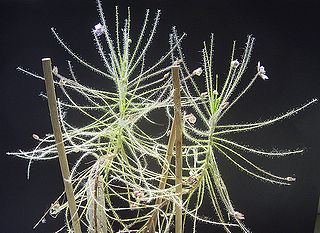
The order Lamiales are an order in the asterid group of dicotyledonous flowering plants. It includes about 23,810 species, 1,059 genera, and is divided into about 25 families. These families include Acanthaceae, Bignoniaceae, Byblidaceae, Calceolariaceae, Carlemanniaceae, Gesneriaceae, Lamiaceae, Lentibulariaceae, Linderniaceae, Martyniaceae, Mazaceae, Oleaceae, Orobanchaceae, Paulowniaceae, Pedaliaceae, Peltantheraceae, Phrymaceae, Plantaginaceae, Plocospermataceae, Schlegeliaceae, Scrophulariaceae, Stilbaceae, Tetrachondraceae, Thomandersiaceae, Verbenaceae.

Ophioglossum, the adder's-tongue ferns, is a genus of about 50 species of ferns in the family Ophioglossaceae. The name Ophioglossum comes from the Greek meaning "snake-tongue". Their cosmopolitan distribution is mainly in tropical and subtropical habitats.

Acanthaceae is a family of dicotyledonous flowering plants containing almost 250 genera and about 2500 species. Most are tropical herbs, shrubs, or twining vines; some are epiphytes. Only a few species are distributed in temperate regions. The four main centres of distribution are Indonesia and Malaysia, Africa, Brazil, and Central America. Representatives of the family can be found in nearly every habitat, including dense or open forests, scrublands, wet fields and valleys, sea coast and marine areas, swamps, and mangrove forests.

Bignoniaceae is a family of flowering plants in the order Lamiales commonly known as the bignonias or trumpet vines. It is not known to which of the other families in the order it is most closely related.

The Verbenaceae, the verbena family or vervain family, is a family of mainly tropical flowering plants. It contains trees, shrubs, and herbs notable for heads, spikes, or clusters of small flowers, many of which have an aromatic smell.

Lentibulariaceae is a family of carnivorous plants containing three genera: Genlisea, the corkscrew plants; Pinguicula, the butterworts; and Utricularia, the bladderworts.

Byblis is a small genus of carnivorous plants, sometimes termed the rainbow plants for the attractive appearance of their mucilage-covered leaves in bright sunshine. Native to Australia and New Guinea, it is the only genus in the family Byblidaceae. The first species in the genus was described by the English botanist Richard Anthony Salisbury in 1808. Eight species are now recognised.

Phrymaceae, also known as the lopseed family, is a small family of flowering plants in the order Lamiales. It has a nearly cosmopolitan distribution, but is concentrated in two centers of diversity, one in Australia, the other in western North America. Members of this family occur in diverse habitats, including deserts, river banks and mountains.

Pedaliaceae, the pedalium family or sesame family, is a flowering plant family classified in the order Lamiales. The family includes sesame, the source of sesame seeds.

Calceolariaceae is a family of flowering plants in the order Lamiales that has been recently segregated from Scrophulariaceae. The family includes three genera, Calceolaria, Porodittia, and Jovellana, but analysis suggests that the monotypic Porodittia should be placed within Calceolaria. Recent molecular phylogenies that included Calceolaria have shown not only that this genus does not belong in Scrophulariaceae but also that it is the sister clade to the majority of the other families of the Lamiales. Morphological and chemical characters also support the separation of Calceolariaceae from Scrophulariaceae and other Lamiales. Some recent studies have supported a sister-group relationship between Calceolariaceae and Gesneriaceae. Given this close relationship, some authors opt to merge this family into Gesneriaceae as subfamily Calceolarioideae

Martyniaceae is a family of flowering plants in the Lamiales order that are restricted to the Americas. The family was included in Pedaliaceae in the Cronquist system but is recognized as a separate family by the Angiosperm Phylogeny Group on the basis of phylogenetic studies that show that the two families are not closely related. Both families are characterized by having mucilaginous hairs — which give the stems and leaves a slimy or clammy feel — and fruits with hooks or horns. Some members of the genus Proboscidea are known as "unicorn plant" or "devil's claw" because of their horned seed capsules.

Cotula is a genus of flowering plant in the sunflower family. It includes plants known generally as water buttons or buttonweeds.

Linderniaceae is a family of flowering plants in the order Lamiales, which consists of about 25 genera and 265 species occurring worldwide. Vandellia micrantha is eaten in Laos, but tastes bitter. Best known are the wishbone flowers Torenia fournieri and Torenia thouarsii, which are used as bedding plants, especially in the tropics. Micranthemum is sold as an aquarium plant when it is called 'baby tears'.

Lindenbergia is a genus of herbaceous plants in the order Lamiales and in the broomrape family Orobanchaceae. It is one of the few genera of the family which are not parasitic. It contains about 15 species found from northeast Africa across Asia to the Philippines, and is most abundant in India.

The Carlemanniaceae are a tropical East Asian and Southeast Asian family of subshrub to herbaceous perennial flowering plants with 2 genera. Older systems of plant taxonomy place the two genera, Carlemannia, and Silvianthus within the Caprifoliaceae or the Rubiaceae. The Angiosperm Phylogeny Group classification of 2003 places the group in the Lamiales, as a plant family more closely related to the Oleaceae than to the Caprifoliaceae.
The APG III system of flowering plant classification is the third version of a modern, mostly molecular-based, system of plant taxonomy being developed by the Angiosperm Phylogeny Group (APG). Published in 2009, it was superseded in 2016 by a further revision, the APG IV system.

Peltanthera is a genus of flowering plants containing a single species, Peltanthera floribunda. The genus was originally placed in family Loganiaceae and has since been variously placed in Buddlejaceae, Scrophulariaceae, Gesneriaceae, or in its own family Peltantheraceae. In 2016, it was considered by the Angiosperm Phylogeny Group to be unplaced in any family, but within the order Lamiales, while Christenhusz et al. in 2017 placed it in family Gesneriaceae as subfamily Peltantheroideae. The placement in Gesneriaceae was accepted by Plants of the World Online as of March 2024.

Mazaceae is a family of plants in the order Lamiales. The family was described by James L. Reveal in 2011. Genera in this family were most recently previously included in Phrymaceae and in older classifications were placed in Scrophulariaceae.
Carlemannia is a genus of flowering plants in the family Carlemanniaceae, found in Nepal, the eastern Himalaya, Assam, Tibet, south-central and southeast China, Indochina, and Sumatra. Basal in their lineage, which is now thought to be the Lamiales, they have a chromosome count of 2n=30.

















